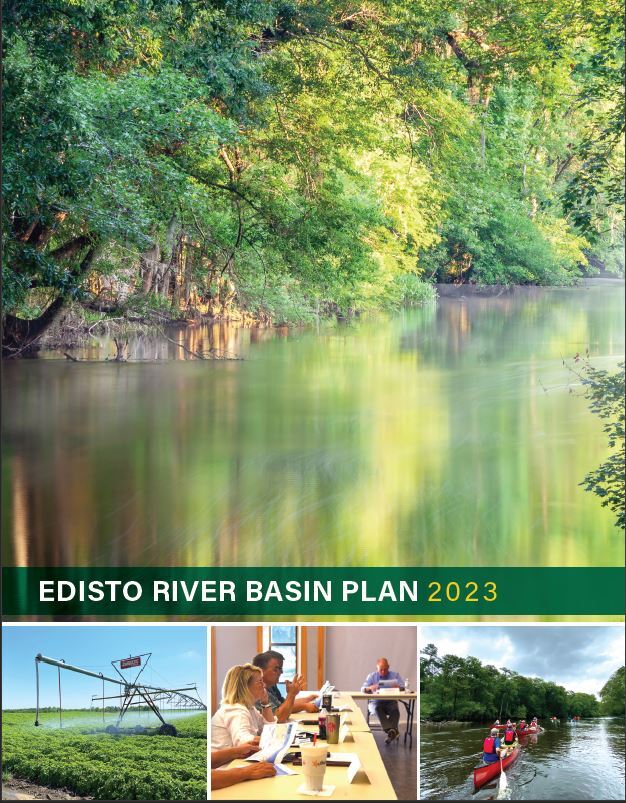
Edisto IV – 64″x40″ Batik on Silk, Mary Edna Fraser 1999
 |
| SCDNR to present final Edisto River Basin Plan June 1 in Blackville |
 The Edisto River Basin Plan is available for review and download on the SCDNR website at https://hydrology.dnr.sc.gov/edisto-river-basin-plan.html. The Edisto River Basin Plan is available for review and download on the SCDNR website at https://hydrology.dnr.sc.gov/edisto-river-basin-plan.html. |
| The S.C. Department of Natural Resources (SCDNR) will hold a public meeting on June 1 in Blackville to introduce the final Edisto River Basin Plan to the basin’s stakeholders.The Edisto River Basin Plan was developed over a two-and-a-half-year period by the Edisto River Basin Council, a working group of stakeholders with water interests in the basin, under the guidance of the South Carolina State Water Planning Framework published in 2019. The plan is the first of eight River Basin Plans scheduled to be completed over the next several years for each of the eight planning basins in the State. The plan includes an assessment of current and future water availability in the basin and documents water management strategies that can help ensure water is available for all future uses in the basin for the next 50 years. The Edisto River Basin Plan is available for review and download on the SCDNR website at https://hydrology.dnr.sc.gov/edisto-river-basin-plan.html.The public meeting will serve as a venue for presenting the final plan to the basin’s stakeholders and for addressing public comments received on the draft plan released earlier this year. Public engagement is critical to the goal of ensuring that future generations of South Carolinians have secure, well-managed supplies of our most critical natural resource—water.You can download a copy of the South Carolina State Water Planning Framework and learn more about the South Carolina river basin planning process at: https://hydrology.dnr.sc.gov/state-and-river-basin-planning.html.Meeting Location and Time:June 1, 2023, 6-8 p.m.Clemson Edisto Research and Education Center64 Research St.Blackville, SC 29817[Directions via Google Maps] |
Climate Central
May 2023
Charleston Airbourne Flooded is a 96″x36″ Batik on Silk by Mary Edna Fraser that depicts the effects that sea level rise could have on the Charleston, SC coastline. The dark green areas show the future encroachment of water on our coastal land.
Trees provide powerful benefits in an increasingly warm and urbanized world. Trees help communities reduce heat, avoid flooding from stormwater runoff, improve air quality, remove and store greenhouse gases, and protect health while providing a connection to nature.
Cities are incorporating nature into their infrastructure to help alleviate impacts of urbanization and build resilient communities.
Click below to explore the power of trees in addressing the impacts of climate change in your area.
Read more
Explore your location
How is climate change influencing daily heat extremes in your local area?
Climate Central’s U.S. Climate Shift Index™ Map tool provides real-time estimates of how much climate change is affecting daily high and low temperatures across the continental U.S.
The Global Climate Shift Index™ Map tool shows the influence of climate change on daily average temperatures across the entire globe.
Access our report and tools below to see how climate change is influencing daily heat extremes where you live and work, and how extreme heat is affecting our health.
Frequency of risky heat
Climate Shift Index™ Explained
Climate Central, in partnership with UC Berkeley and UCLA, is proud to announce the publication of a new peer-reviewed study analyzing the risks sea level rise and coastal flooding pose to hazardous facilities and the socially vulnerable communities near them in California.
Our research found that over 120 hazardous facilities, including oil refineries, landfills, and sewage treatment plants, will be at risk of coastal flooding by 2050, and over 400 could be at risk by the end of the century if carbon pollution is allowed to grow unchecked. When hazardous facilities flood they can release dangerous substances, exposing nearby residents to toxic floodwaters.
Socially marginalized populations, including those with higher proportions of residents living in poverty, residents of color, renters, linguistically isolated households, elderly residents, and single-parent households had a higher likelihood of living near an at-risk hazardous facility.
Use our Coastal Risk Screening Tool to see which facilities/communities in California are at risk.
Read the peer-reviewed study
Read the press release
Our programs foster understanding that climate change is happening—here and now, in our own hometowns. With your support, we are scaling our work to reach more Americans, more often, with vital messages about how climate change is already affecting us all.
Support our work